Further reading
- 1.Narasimha Satakamu at AVKF
- 2.Narasimha Satakamu: Sheshappa Balasaraswathi Book Depot, Eighth edition, 1977, Madras.
Narasimha Satakam is a compilation of 100 poems by Seshappa. They are primarily based on devotion and morality and set in simple language.

Narasimha, sometimes rendered Narasingha, is the fourth avatar of the Hindu god Vishnu. He is believed to have incarnated in the form of a part-lion, part-man being to kill Hiranyakashipu, to end religious persecution and calamity on earth, thereby restoring dharma. Narasimha is often depicted with three eyes, and is described in Vaishnavism to be the God of Destruction; he who destroys the entire universe at the time of the great dissolution (Mahapralaya). Hence, he is known as Kala (time) or Mahakala (great-time), or Parakala in his epithets. There exists a matha (monastery) dedicated to him by the name of Parakala Matha at Mysuru in the Sri Vaishnava tradition. Narasimha is also described as the God of Yoga, in the form of Yoga-Narasimha.
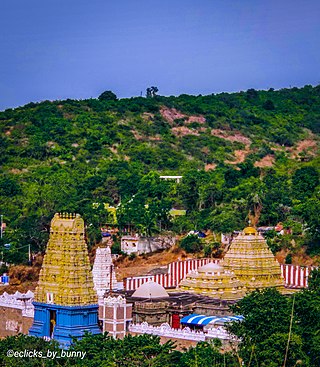
Sri Varaha Lakshmi Narasimha temple, Simhachalam, is a Hindu temple situated on the Simhachalam Hill Range,which is 300 metres above the sea level in Visakhapatnam, Andhra Pradesh, India. It is dedicated to Lord Vishnu, who is worshipped there as Varaha Narasimha. As per the temple's legend, Vishnu manifested in this form after saving his devotee Prahlada from a murder attempt by the latter's father Hiranyakashipu.Except on Akshaya Trutiya, the idol of Varaha Narasimha is covered with sandalwood paste throughout the year, which makes it resemble a linga. The temple was built in Kalingan architecture styles and stands unique in the historical region of Kalinga.The Present temple was built by Eastern Ganga king Narasingha Deva I in the 13th century and consecrated by his son Bhanudeva I in 1268 AD. The temple was built by Akthayi Senapathi, on the command of Narasingha Deva I.

Telugu literature is the body of works written in the Telugu language. It consists of poems, short stories, novels, plays, and song lyrics, among others. There is some indication that Telugu literature dates at least to the middle of the first millennium, the first extant works are from the 11th century when the Mahabharata was first translated to Telugu from Sanskrit by Nannaya. The language has experienced a golden age under the patronage of the Vijayanagara Emperor-Poet Krishnadevaraya.
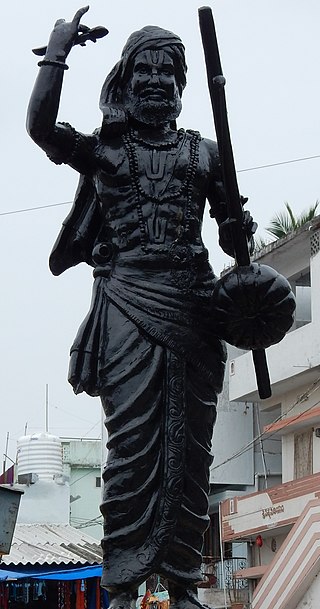
Kancharla Gopanna, popularly known as Bhakta Ramadasu or Bhadrachala Ramadasu, was a 17th-century devotee of the Hindu god Rama, a saint-poet and a composer of Carnatic music. He is a famous Vaggeyakara from the Telugu classical era. He was born in the village of Nelakondapalli in Khammam district, and orphaned as a teenager. He spent his later years in Bhadrachalam and 12 years in solitary confinement at the Golconda prison during the Qutb Shahi-rule. Different mythical stories about his life circulate in the Telugu tradition. He is renowned for constructing the famous Sita Ramachandraswamy Temple and pilgrimage center on the banks of river Godavari at Bhadrachalam. His devotional kirtana lyrics to Rama illustrate the classical Pallavi, Anupallavi and Caranam genre composed mostly in Telugu, some in Sanskrit and with occasional use of Tamil language. These are famous in South Indian classical music as Ramadaasu Keertanalu.

Roddam Narasimha FRS was an Indian aerospace scientist and fluid dynamicist. He was a professor of Aerospace Engineering at the Indian Institute of Science (1962–1999), director of the National Aerospace Laboratories (1984–1993) and the chairman of the Engineering Mechanics Unit at Jawaharlal Nehru Centre for Advanced Scientific Research. He was the DST Year-of-Science Chair Professor at JNCASR and concurrently held the Pratt & Whitney Chair in Science and Engineering at the University of Hyderabad. Narasimha was awarded the Padma Vibhushan, India's second-highest civilian award, in 2013. for his contributions to advance India's aerospace technology.

The Sri Lakshmi Narasimha Swamy Temple or simply known as Yadadri or Yadagirigutta temple, is a Hindu temple situated on a hillock in the small town of Yadagirigutta in the Yadadri Bhuvanagiri district of the Indian state of Telangana. Yadadri temple is touted as Telangana's own Tirupati. The temple is dedicated to the god Narasimha, an avatar of Vishnu.
Simhadri may refer to:
Balijepalli Lakshmikantha Kavi was an Indian playwright, novelist, poet, screenwriter, actor and freedom fighter. He is remembered for the magnum opus Satya Harischandriyamu, a play written in 1924, and for his works in Telugu cinema.
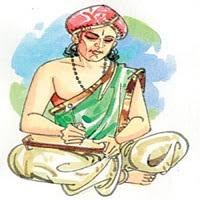
Sumati Satakam is one of the most famous Telugu Satakams. It is a neeti (moral) Satakam.
Simhadri Narasimha Satakam is a compilation of Telugu poems by Gogulapati Kurmanatha Kavi in the 18th century. He wrote the Satakam extempore in praise of Lord Varaha Narasimha of Simhachalam.

Garikipati Narasimha Rao is an Indian scholar, litterateur, and avadhani from Andhra Pradesh. In 1996, he performed Avadhanam with 1116 Pruchchakas for 21 days in Kakinada. He also delivers lectures on personality development based on dharmic culture and way of life. He regularly appears on Telugu TV channels like SVBC, Bhakti TV, and ABN Andhra Jyothi giving discourses on ancient Hindu texts like Bhagavadgita, Ramayana, and Mahabharata. In 2022, he was awarded India's fourth-highest civilian award Padma Shri by the government of India.

Kasula Purushottama Kavi was a Telugu poet who lived during the late 18th century. His parents were Kasula Appalaraju and Ramanamma. He hailed from the Diviseema area of Krishna District, Andhra Pradesh. He was a court poet of the then-Raja of Challapalli, Yarlagadda Ankineedu Prasad I of the Challapalli Samasthanam and possibly of his father as well. Purushottama Kavi is recognized for composing literary works in Telugu consisting of one hundred poetic stanzas, known as satakams.

Andhra Vishnu, better known as Srikakula Mahavishnu statue, was set up in Andhra in a pre-existing older temple. The previous deistic form worshiped in the temple is unknown.
Rambhatla Lakshminarayana Sastry(b: 9 December 1908 - d: 19 November 1995) was an eminent Indian teacher, author, playwright, translator, commentator and speaker in Telugu & Sanskrit languages. Sastry's life and notable works have been documented and covered in Telugu University under Luminaries of 20th Century.

Pamulaparthi Venkata Narasimha Rao, popularly known as P. V. Narasimha Rao, was an Indian lawyer, statesman and politician who served as the 9th prime minister of India from 1991 to 1996. He is known for introducing various liberal reforms to India's economy. His ascendancy to the prime ministership was politically significant because he was the second holder of this office from a non-Hindi-speaking region (Telugu) and the first from South India. He led an important administration, overseeing a major economic transformation and several home incidents affecting national security of India. Rao, who held the Industries portfolio, was personally responsible for the dismantling of the Licence Raj, as this came under the purview of the Ministry of Commerce and Industry, reversing the economic policies of Rajiv Gandhi's government.
A shataka is a genre of Sanskrit literature. It comprises works that contain one hundred verses. It is also a popular genre of Telugu literature.
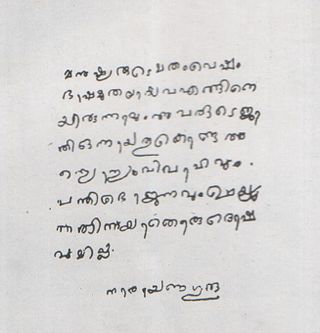
Ātmopadesa Śatakam is a Malayalam spiritual work by Narayana Guru in the form of a poem. It is considered as the classic work of Narayana Guru, who was a social reformer and spiritual leader of Kerala, India. The literal translation of the title means "One Hundred Verses of Self Instruction". "Atmopadesa Śatakam" contained 100 verses or stanzas, each of which describing a set of actions performed by the self on itself, affecting and recognising moments of transformation into an absolute value.
Narayana Purushothama Mallaya is an Indian author, known for his activism for Konkani language and literature. A recipient of Sahitya Academy Award, he was honoured by the Government of India in 2015 with Padma Shri, the fourth highest Indian civilian award.
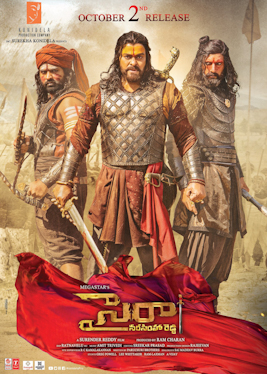
Sye Raa Narasimha Reddy is a 2019 Indian Telugu-language epic historical action film directed by Surender Reddy and produced by Ram Charan under the Konidela Production Company banner. Surender Reddy scripted the film based on an original story given by Paruchuri brothers. A work of fiction, the film is inspired by the life of Indian independence activist Uyyalawada Narasimha Reddy from the Rayalaseema region of Andhra Pradesh. The film stars Chiranjeevi as the title character with Nayanthara, Tamannaah Bhatia, Sudeep, Jagapathi Babu, and Vijay Sethupathi in supporting roles. Amitabh Bachchan and Anushka Shetty make guest appearances. Pawan Kalyan, Kamal Haasan, and Mohanlal gave narration in the film. The film tells the story of Narasimha Reddy in his fight against the rule of the British East India Company.
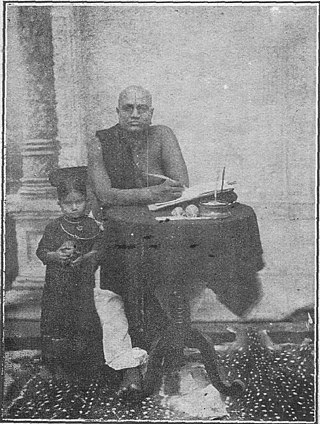
Mahakavi Dasu Sriramulu (1846–1908) was an Indian scholar, poet, orator, author, astrologer, avadhani, translator, and social reformer. He was a lawyer by profession. He was a child prodigy. He had no formal tutelage in these diverse arts – his knowledge was gained through his personal studies and association with scholars and artists.